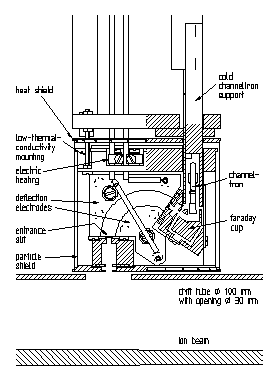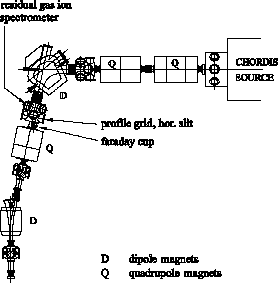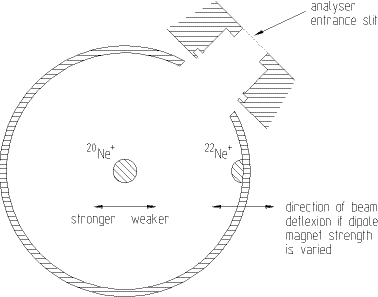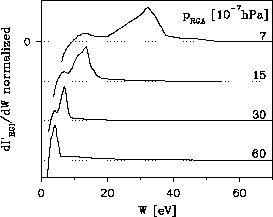Low energy beam transport of high perveance beams
with magnetic quadrupole focusing requires a high degree of space-charge
compensation. Furthermore the build-up time of space-charge compensation
has to be short compared to the beam-pulse duration. In order
to study the space-charge compensation in the drift sections between
the focusing elements of the existing GSI UNILAC injector, the
energy spectrum of the residual gas ions produced by the beam
and accelerated radially by the space-charge potential can be
measured. Hereto a compact electrostatic energy analyser of the
Hughes-Rojansky type [1] has been built allowing for time integrated
as well as time resolved measurements. First measurements in time
integrating mode have been performed.
Residual gas ions (RGI) are created locally by collisions of beam ions (BI) with residual gas atoms (RGA) proportional to beam current density jBI(r) and to the cross section of the production of RGI sRGI and the density of RGA nRGA. (A thinning of the residual gas by that interaction only takes place at beam densities not reached under our experimental conditions.) Under the assumptions of 1-dim. cylindrical symmetry, positive beam potential f(r) and RGI created at rest, the RGI are accelerated outwards radially in the beam potential. The energy distribution of the RGI dI'RGI/dW (with I'RGI(W) the line current of RGI with energies below W) contains information on jBI(r), f(r) and sRGI nRGA in a folded form. It can be evaluated from measurements with an RGI spectrometer, taking into account the spectral sensitivity of the instrument. E. g. the radial potential distribution f(r) of a compensated DC beam has been reconstructed from dI'RGI/dW and jBI(r). For a decompensated DC beam jBI(r) and f(r) have been derived directly from the RGI energy spectrum dI'RGI/dW and the total beam current IBI via an analytical inversion [2].
Time resolved measurements of the build-up of space-charge
compensation can be performed with a spectrometer using a channeltron
detector and a multi-channel scaler [3].
Besides the energy resolution of the spectrometer given by slit width and acceptance angle (here: 1,6 % due to slit width, +0,4 % due to acceptance angle) some effects can deteriorate the quality of measured RGI energy spectra.
1-dim. cylindrical symmetry is essential for a simple interpretation of RGI energy spectra. The symmetry of the beam potential is supported by a cylindrical drift tube of sufficient length surrounding the beam at the axial position of the spectrometer. Disturbing external electric fields are minimised by it but the effect of an asymmetry of the beam cannot be suppressed.
An asymmetry of the beam (or total charge configuration) as well as charging of isolating surface layers in drift tube and spectrometer or external magnetic fields can diminuate the number of RGI arriving at the spectrometer under proper angles.
The detected RGI current is lowered in the same way due to the non-radial movement of RGI created with non-zero energies. For the given geometry and thermal start energies this is significant only for detected RGI energies below 3 eV and can be corrected to some extent [2].
The space charge of RGI on the way from the drift tube to the entrance slit of the spectrometer causes a widening of the RGI "beam". This can be significant because it is not unusual that the perveance of the RGI "beam" exceeds that of the ion beam. The resultant decrease of detected RGI intensity is strongly chromatic. Hence the spectrometer has to be positioned as near as possible to the cylindrical drift tube.
In the case of strong production of secondary electrons by the beam, a negative signal is superimposed at the low energy end (up to a few eV) of the RGI energy spectrum. This is due to secondary electrons irregularly passing the spectrometer by multiple reflexions.
Fluctuations of beam current or beam diameter can result in a broadening of the RGI energy spectra. (An indication for the quality of a spectrum is a sharp decrease at the high-energy end.)
The build-up of space-charge compensation with time
results in a broadening of spectra measured time integrated at
pulsed beams.
An electrostatic energy analyser with an energy resolution of 2 % at an acceptance angle of +- 6° for both directions has been built (Fig. 1). It has been operated with Faraday cup and electrometer amplifier for time integrated absolute measurements. Operation with channeltron in single particle counting mode for time resolved measurements [3] and measurements at low intensities is foreseen. (The channeltron is not mounted yet.) The RGI flux has to be adjustable to the pulse counting capability of the channeltron (106 s-1). This is provided by accelerating the RGI to an electrode (the bottom of the Faraday cup) and detecting the secondary electrons. The secondary electron flux to the entrance of the channeltron is controlled by a (second) variable accelerating voltage. Both modes of operation can be performed without changes of the spectrometer.

The spectrometer is well shielded against irregular particles but no measures are taken to prevent secondary electrons from irregularly passing it by multiple reflexions at the deflector plates.
Electric heating of the spectrometer is possible in order to prevent gaseous surface layers. Due to a separate heat shield and a mounting with low thermal conductivity, only 12 watt are required to maintain a temperature of 200 °C (more seems possible). At the same time the channeltron which is mounted in a separate housing stays below 50 °C. Non-magnetic material was used throughout. All stainless steel parts are annealed at 1000 °C. The analyser is mountable in a tube of 100 mm diameter.

The RGI energy analyser was mounted in a standard
diagnostic box in the GSI injector after the mass separating dipole
magnet (Fig. 2). A drift tube of 100 mm inner diameter and 270
mm length was inserted into the box. A pulsed Ne+ beam
of 232 keV, approx. 16 mA, 25 Hz repetition rate and 0.67 ms pulse
duration was used. The 20Ne+ fraction was
adjusted to the axis of the beam tube with a diameter of approx.
10 mm. A 10 % 22Ne+ fraction hit the drift
tube approximately at the axial position of the RGI energy analyser
(Fig. 3).

20 cm downstream of the RGI energy analyser the beam
passed between the two electrodes of a motorised slit (spacing
55 mm). These could be biased positively in order to decompensate
the beam. 1.3 meter further downstream (after a quadrupole doublet)
the beam was stopped without secondary electron suppression.
The influence of an increase of residual gas pressure on the RGI energy spectra is shown in Fig. 4. The maximum beam potential decreases as well as the potential drop inside the beam which falls from approx. 20 V to below 5 V. Compared to a theoretically estimated maximum potential of approx. 500 V and a potential difference of approx. 100 V in the decompensated beam this indicates high degrees of space-charge compensation. At 7 . 10-7 hPa the steep decrease at the high-energy end of the spectrum points to a build-up time shorter than the theoretical build-up time t = (sRGI nRGA vBI)-1 of approx. 200 ms (vBI velocity of BI).

Nevertheless, caution has to be taken with this interpretation
because two anomalous facts were observed: 1. Generally at low
pressure or with decompensated beam the beam position had an unusual
strong influence on the spectra. 2. At high decompensation voltages
the maximum of observed RGI energies was far below the theoretically
expected 500 eV. This effect persisted even if the decompensating
electrode was moved into the beam. Up to now these effects are
not fully understood. A possible reason is the disturbed symmetry
due to the space charge of the 22Ne+ fraction
and the secondary electrons produced by it. If this is confirmed
by experiments with a pure 20Ne+ beam or
a He+ beam the RGI energy analyser will be shifted
to an other location.
The influence of beam parameters as diameter, pulse
length, current and current fluctuations and of residual gas pressure
on the space-charge compensation will be studied. As well time
resolved measurements (time resolution 2 ms)
of the build-up of space-charge compensation in the pulsed UNILAC
beam are planned for the near future. The hard- and software for
channeltron operation and data analysis are in preparation.
[1] A. L. Hughes and V. Rojansky, Phys. Rev. 34, p284 (1929)
[2] R. Dölling, Thesis, IAP, Frankfurt (1994)
[3] K. Reidelbach, J. Pozimski, P. Groß, A. Jakob, R. Dölling and
H. Klein, GSI-96-02, p45 (1996)